Key Points:
- Although Maryland can be hot and humid in the summer, it has cold and dry winters, so most of the snakes go dormant at that time.
- Of the 27 snakes in Maryland, only 2 are venomous, so there is not much worry about snakes when people are involved in outdoor activities.
- Non-venomous snakes are generally helpful because they eliminate rodents and other pests.
- In the complete list of Maryland’s snakes toward the bottom of this article, you’ll find some interesting names like milk, queen, rainbow, scarlet, red corn, red-bellied, plain-bellied, smooth earth, and smooth green.

Outdoor enthusiasts in Maryland needn’t worry about snakes: they are mostly dormant in winter and there are only two venomous ones.
©ladyphoto89/Shutterstock.com
Maryland has a wide variety of snakes that inhabit the state but only two of them are venomous. That means that people who love the outdoors can enjoy all the hiking, fishing, swimming, camping, and outdoor activities that Maryland has to offer without being too concerned about the possibility of running into venomous snakes. The hot and humid summers are when snakes are in Maryland are the most active.
Because Maryland’s winters are primarily cold and dry that’s when most of the snakes that live in Maryland go dormant. From the forests to the grasslands and the many rivers, lakes, and waterways that make up the geography of Maryland there are snakes in all parts of the state. These are the poisonous snakes in Maryland that you’re most likely to see when you’re outdoors:
The Most Common Snakes in Maryland
While most of the attention on snakes focuses on venomous species, the truth is that the most common snakes in Maryland are not poisonous. These snakes are generally helpful as they eliminate rodents and other pests. Here are a few of the more common nonvenomous snakes in Maryland.
Garter Snake
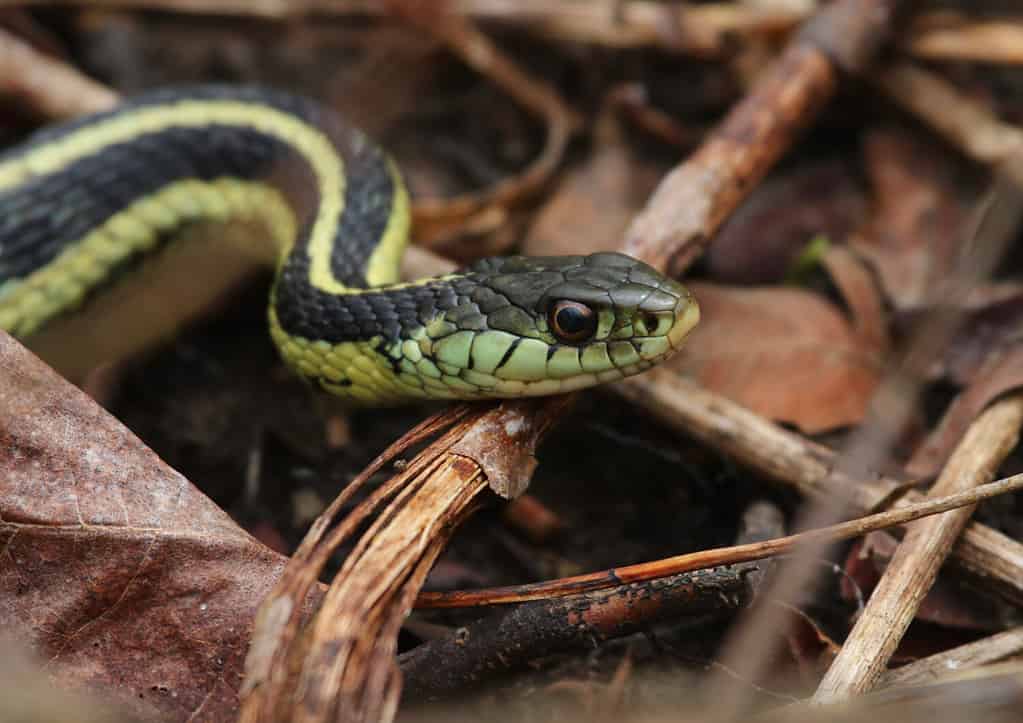
Garter snakes are common throughout Maryland, and harmless to humans.
©Chris Hill/Shutterstock.com
Garter snakes are very common throughout the state, so if you see a snake when you’re in Maryland it’s probably going to be a garter snake. They can be black, dark green, or any shade of brown with a yellow or a white stripe running down the length of the snake’s back.
These snakes are not large and usually don’t get to be longer than about two feet. Garter snakes are often found in backyards, especially rural or wooded backyards, so teach your kids what a garter snake looks like if you are worried that snakes might be in your back yard.
There are a lot of garter snakes in Howard, Frederick, Baltimore, and Anne Arundel counties.
Eastern Rat Snake
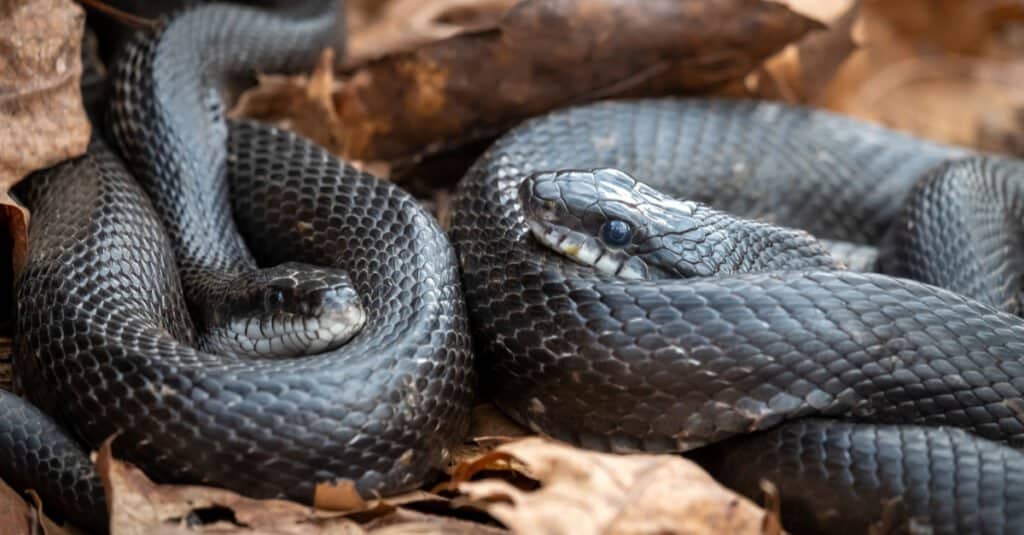
Eastern ratsnakes, shown snuggling during spring, are not venomous or aggressive.
©samray/Shutterstock.com
Rat snakes are one of the largest types of snakes that you’ll find in Maryland. Typically rat snakes are black with white markings. These snakes can be more than 80 inches long. That’s almost seven feet long! But, you don’t need to be afraid of the rat snake even though its size can be intimidating. These snakes are not venomous and usually they’re not very aggressive.
Rat snakes are helpful snakes because they feed primarily on rodents like rats and mice. They prefer the types of habitats where rodents live, primarily mountain territory or flat grasslands.
Northern Brown Snake
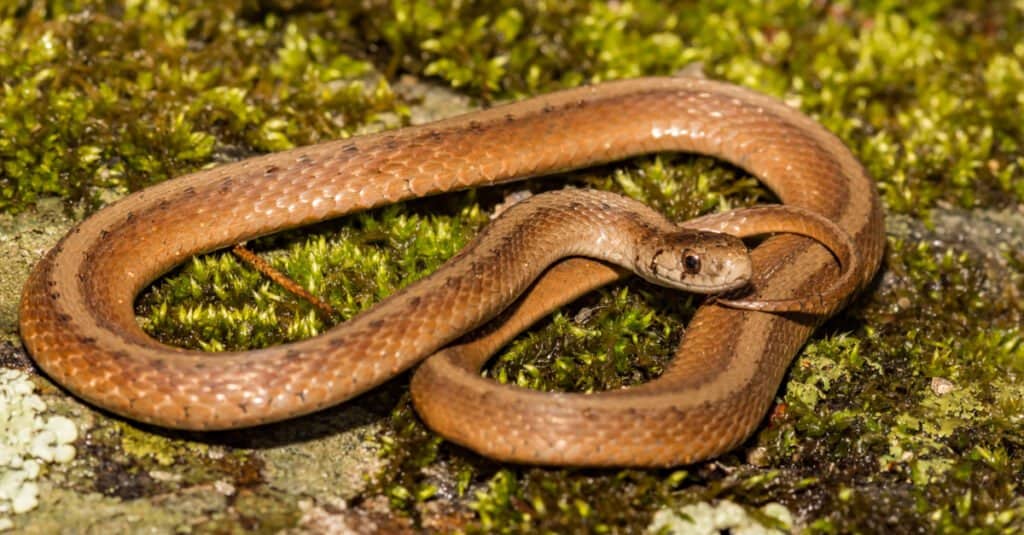
Northern brown snakes are one of the smaller snake species found in Maryland.
©Jay Ondreicka/Shutterstock.com
The northern brown snake is the opposite of the rat snake. It’s one of the smallest snake species that you’ll see in Maryland. As the name suggests the northern brown snake is brown and it has black or reddish spots all the way down the back. They are nocturnal so you will really only see them if you are camping, or if you are hunting or hiking before dawn.
Northern brown snakes are not venomous and typically don’t bite even if you pick one up.
Northern Racer
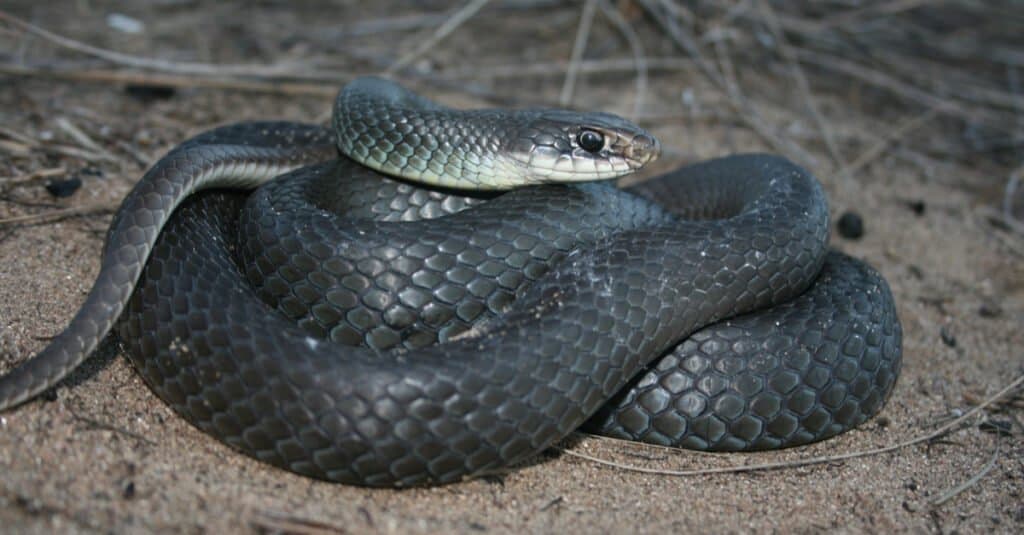
Racer snakes are identifiable by their long, thin bodies with dark backs and light-colored bellies.
©Psychotic Nature/Shutterstock.com
The northern racer is another very large type of snake, although it’s not as big as the rat snake. Generally, Northern Racer snakes don’t grow longer than 60 inches. These snakes are black or dark brown and tend to stick to areas where they can camouflage themselves easily like wooded areas and rocky areas. Northern Racers are exceptionally fast.
If you see one and blink, it will be out of range before you’re done blinking. If you do see a northern racer while you’re out enjoying the outdoors in Maryland, you most likely won’t see it for long.
Ring-Necked Snake
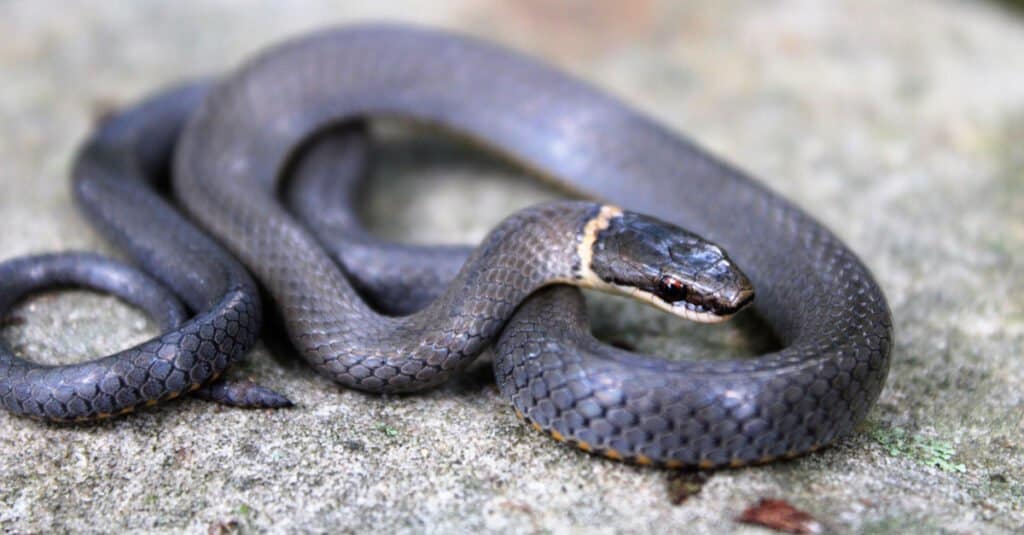
Small and colorful, the ring-necked snake is nocturnal and non-venomous.
©Tucker Heptinstall/Shutterstock.com
The ring-necked snake has a very distinctive appearance. They’re only about a foot long but they have either cream or yellow ring marking around their necks, which is where they got their name. Ring-necked snakes love to be in damp, dark, moist places so you will mostly find them in the northern counties near the border with Pennsylvania and also along the Eastern Shore of Maryland.
You may also find some in urban areas or suburban areas in brush piles, rotting tree stumps, mulch piles and landscaping, and basements. If you do find these little snakes in your yard or basement don’t worry, they are not venomous.
Venomous (Poisonous) Snakes in Maryland
Maryland only has two types of venomous snakes, which is good if you’re afraid of them. Whenever you are hiking in an area where venomous snakes are known to live one way that you can stay safe is to stay on the dedicated hiking trails. Choose a wide well-traveled trail to hike on and don’t make your own paths. Snakes will usually stick to the brush and stay far away from man-made trails where people tend to be.
If you are out hunting, hiking, or taking your kids out in the woods and you come across a snake don’t panic. Move very slowly and back up, never approach the snake. If you can you should wait for the snake to move away before walking away.
If you can’t wait then continue to back up and away from the snake. It also is a good idea to know what types of snakes live in the area where you are going to be. The two types of venomous snakes in Maryland that you need to watch out for are:
Eastern Copperhead
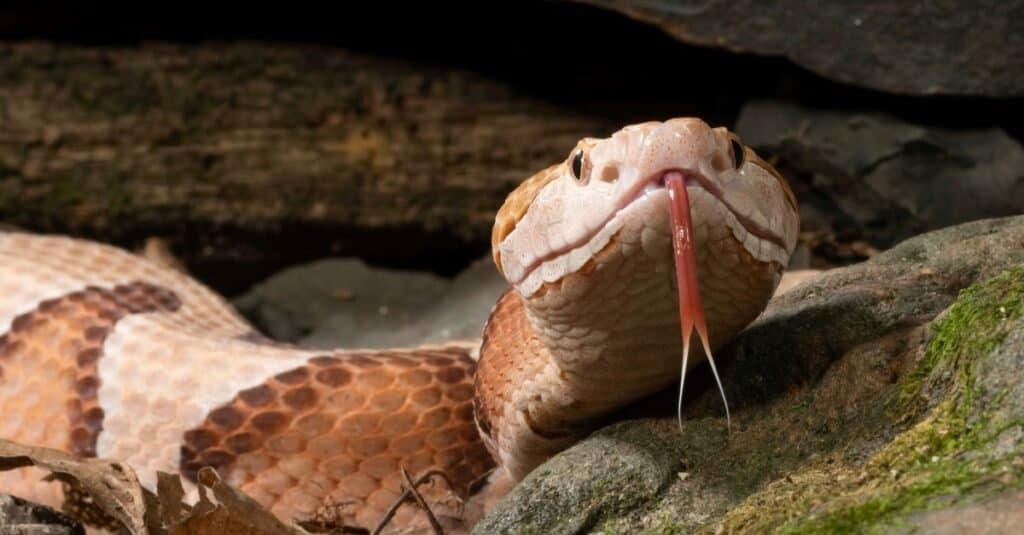
Copperhead snakes are found throughout most of Maryland, but may be absent near the Eastern Shore.
©Joe McDonald/Shutterstock.com
Eastern copperheads have a very unique color pattern which will help you recognize one when you see it. Their heads are a brown copper color and their bodies may be mottled brown and black or shades of brown and white. They’re not very large and only get to be about 40 inches long. The eastern copperhead is active during the day for most of the year but when the hot and humid summer comes they are mostly nocturnal. If you’re camping in Maryland in the summer, be aware of your surroundings and keep an eye out for these snakes.
Timber Rattlesnake
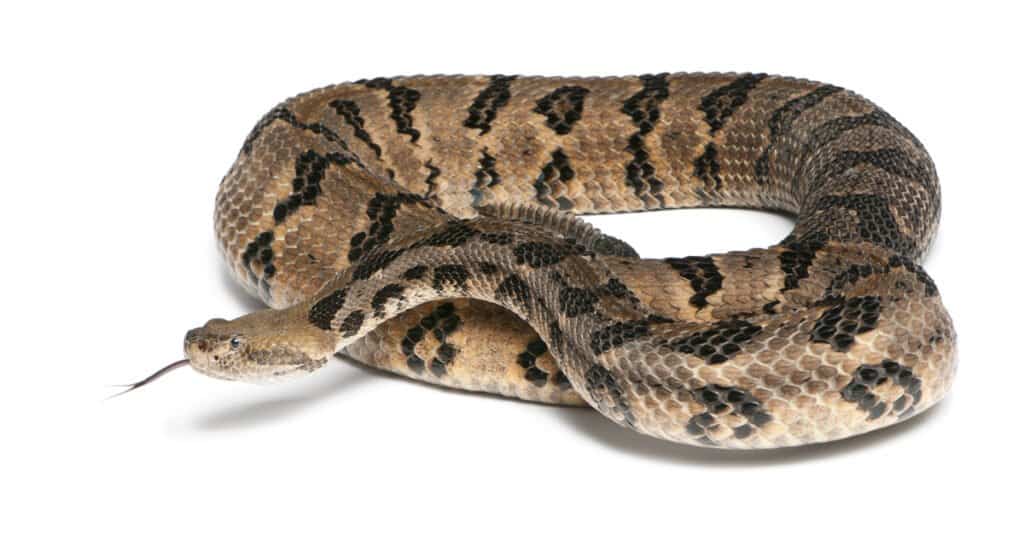
Timber rattlesnakes
are mostly found in the western half of Maryland and away from the Chesapeake watershed.
©Eric Isselee/Shutterstock.com
Timber rattlesnakes are mostly forest dwellers that prefer dark deciduous forests and grassy areas near deciduous forests. These rattlesnakes can have dark coloring or a light gray coloring with black markings. Timber rattlesnakes are not very long and typically are around 50 inches long, although they can grow up to 60 inches long. Like most rattlesnakes, they have a wide heavy body and a loud tail rattle.
Timber rattlers typically won’t attack unless they feel cornered or threatened. However, if you surprise one in the forest while you’re hiking it may strike out because you surprised it. Tread lightly as you go through forests and stay on the hiking paths. Avoid any fallen trees, hollowed-out stumps, or piles of leaves and vegetation because there may be a timber rattlesnake hiking in there. If bitten by a timber rattlesnake, it’s very important to seek immediate medical attention.
Summary of Snakes Found in Maryland
Here’s a recap of the venomous and non-venomous snakes found in the state of Maryland that we took a detailed look at:
| Number | Snake Name | Snake Type |
|---|---|---|
| 1 | Garter Snake | Non-Venomous |
| 2 | Rat Snake | Non-Venomous |
| 3 | Northern Brown Snake | Non-Venomous |
| 4 | Northern Racer | Non-Venomous |
| 5 | Ring-Necked Snake | Non-Venomous |
| 6 | Eastern Copperhead | Venomous |
| 7 | Timber Rattlesnake | Venomous |
10 Black Snakes in Maryland
Of the 27 snakes in Maryland, 10 of them are black, or mostly black. If you’d like to narrow down the types of snakes in this state, you might want to look at our article on black snakes by clicking here or on the title below.
These (mostly) black snakes include:
- Eastern rat snake – black and white belly
- Eastern ribbon snake – yellow belly
- Red-bellied snake – red belly
- plain-bellied snake – red or yellow belly
- Eastern kingsnake – white bands
- Common garter – yellowish stripes
- Ring-necked – brightly colored rings around neck
- Northern water snake – dark crossbands
- Easter racer – cream/yellow belly
- Timber rattlesnake – dark, hard-to-see markings.
The Complete List of Snakes You Will Find in Maryland
If you’re planning on visiting Maryland or if you live there and spend a lot of time outdoors luckily the snakes in Maryland are overall pretty harmless. The full list of snakes in Maryland is:
- Common Garter snake
- Common Water snake
- Dekay’s Brown snake
- Eastern Copperhead
- Eastern Hog-nosed Snake
- Milk snake
- Eastern Rat snake
- Eastern Ribbon snake
- North American Racer
- Northern Ring-necked Snake
- Southern Ring-necked Snake
- Timber Rattlesnake
- Coastal Plain Milk snake
- Common Worm snake
- Eastern King snake
- Eastern Pine snake
- Mountain Earth snake
- Northern Mole King snake
- Plain-bellied Water snake
- Queen snake
- Rainbow Snake
- Red Corn snake
- Red-bellied Snake
- Rough Green snake
- Scarlet Snake
- Smooth Earth snake
- Smooth Green snake.
Which U.S. State Has the Most Snake Bites?
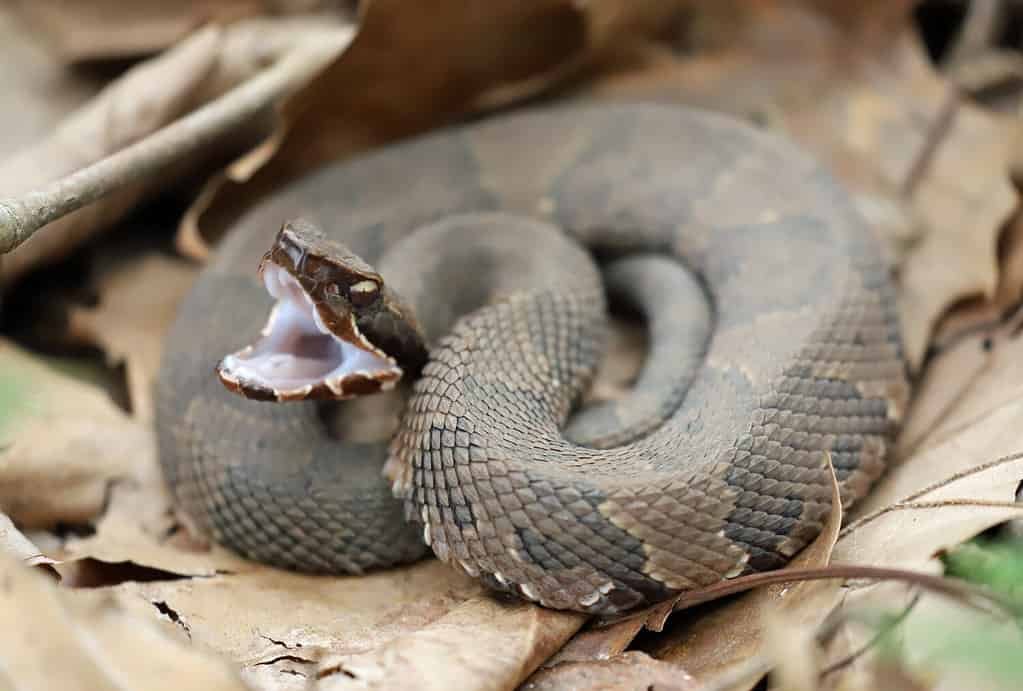
The venomous cottonmouth snake is among those responsible for snake bites in North Carolina.
©KF2017/Shutterstock.com
As you’ve learned, there are quite a few snake species slithering around in the state of Maryland. According to Maryland Poison Control, there are an average of 100 snake bite reports per year, with half of those coming from venomous snakes. The main culprit of those venomous snake bites is the copperhead.
But which state ranks the highest in snake bites? That would be North Carolina. The snake bite rate in this southeastern state is 157.8 bites per million population annually. As the population as of 2021 was a little over 10 million (10.55 to be exact), and we were to just figure it off of 10 million, that would average out to roughly 1,580 reported snake bites per year.
The top 6 states for reported snake bites are:
| Rank | State | Bites per Million |
|---|---|---|
| 1 | North Carolina | 157.8 |
| 2 | West Virginia | 105.3 |
| 3 | Arkansas | 92.9 |
| 4 | Oklahoma | 61 |
| 5 | Virginia | 48.7 |
| 6 | Texas | 44.2 |
There are 6 different kinds of venomous snakes inhabiting North Carolina: copperhead, cottonmouth, eastern coral snake, eastern diamondback rattlesnake, pigmy rattlesnake, and timber rattlesnake. In the year 2019, there were 92 people bitten by venomous snakes in that state.
The photo featured at the top of this post is © Tucker Heptinstall/Shutterstock.com
Discover the "Monster" Snake 5X Bigger than an Anaconda
Every day A-Z Animals sends out some of the most incredible facts in the world from our free newsletter. Want to discover the 10 most beautiful snakes in the world, a "snake island" where you're never more than 3 feet from danger, or a "monster" snake 5X larger than an anaconda? Then sign up right now and you'll start receiving our daily newsletter absolutely free.
Thank you for reading! Have some feedback for us? Contact the AZ Animals editorial team.






